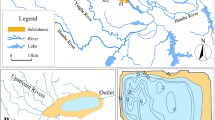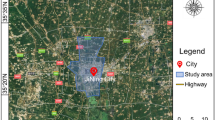Abstract
Subsidence caused by mining can lead to serious waterlogging problems. In this study, numerical simulation was used to predict both subsidence and waterlogging in a coal-mining area. Changes in the phreatic surface and the area of waterlogging caused by mining subsidence were estimated for various mining scenarios using field measurements and simulation analysis. The results of the numerical simulation for the area of waterlogging caused by existing mining subsidence agreed well with the measured results. The simulation results showed that further mining will cause additional subsidence and increase the extent of the waterlogged areas. The numerical simulation method was used to analyze the effects of improvements to the drainage system for different mining scenarios. The improvements included additional drainage channels and raising the height of river embankments to prevent flooding. The results showed that the western drainage improvements have decreased the water table by about 1.0–1.3 m after mining of the No.2 coal seam, while the eastern drainage improvements would decrease the water table by about 2.0 m after mining of the No.4 coal seam. Thus, the area of waterlogging could be effectively managed.























Similar content being viewed by others
References
Azid A, Juahir H, Toriman ME, Kamarudin MKA, Saudi ASM, Hasnam CNC, Aziz NAA, Azaman F, Latif MT, Zainuddin SFM (2014) Prediction of the level of air pollution using principal component analysis and artificial neural network techniques: A case study in Malaysia. Water Air Soil Pollut 225(8):2063
Bekesi G, McGuire M, Moiler D (2009) Groundwater allocation using a groundwater level response management method—Gnangara groundwater system, Western Australia. Water Resour Manag 23(9):1665–1683
Cai M, Kaiser P, Morioka H, Minami M, Maejima T, Tasaka Y, Kurose H (2007) FLAC/PFC coupled numerical simulation of AE in large-scale underground excavations. Int J Rock Mech Min Sci 44(4):550–564
Cherubini C, Giasi C, Pastore N (2012) Bench scale laboratory tests to analyze non-linear flow in fractured media. Hydrol Earth Syst Sci 16(8):2511
Cui X-M, Miao X-X, Zhao Y-L (1999) Discussion on the time function of time dependent surface movement. J China Coal Soc 24(5):453–456
Esterhuizen E, Mark C, Murphy MM (2010) Numerical model calibration for simulating coal pillars, gob and overburden response. In: Proceeding of the 29th international conference on ground control in mining, Morgantown. pp 46–57
Fakhri F, Kalliola R (2015) Monitoring ground deformation in the settlement of Larissa in Central Greece by implementing SAR interferometry. Nat Hazards 78(2):1429–1445
Falcón S, Gavete L, Ruiz A (1996) A model to simulate the mining subsidence problem: coding and implementation of the algorithm. Comput Geosci 22(8):897–906
Guo G-L, Feng W-K, Zha J-F, Liu Y-X, Qiang W (2011) Subsidence control and farmland conservation by solid backfilling mining technology. Trans Nonferrous Metals Soc China 21:s665–s669
Guo G, Zha J, Wang Q, Zhang X (2009) Similar material and numerical simulation of strata movement laws with long wall fully mechanized gangue backfilling. Procedia Earth Planet Sci 1(1):1089–1094
Guo W, Zhao J, Yin L, Jiang N (2017a) Study on Fault Water Inrush Mechanism and Nonlinear Seepage-stress Coupling. J Shandong Univ Sci Technol (Nat Sci) 6:1–7
Guo W, Zhao J, Yin L, Kong D (2017b) Simulating research on pressure distribution of floor pore water based on fluid-solid coupling. Arab J Geosci 10(1):5
He Y, He X, Liu Z, Zhao S, Bao L, Li Q, Yan L (2017) Coal mine subsidence has limited impact on plant assemblages in an arid and semi-arid region of northwestern China. Ecoscience 24(3–4):91–103
Hu R, Yue Z, Lu W, Wang S (2004) Review on current status and challenging issues of land subsidence in China. Eng Geol 76(1–2):65–77
Isiaka AI, Sehoole L, Durrheim R, Manzi M (2017) Integrated high-resolution seismic and electrical Resistivity investigation of subsidence and sinkholes at abandoned coal mine sites in south Africa. In: International Conference on Engineering Geophysics, Al Ain, United Arab Emirates, 9–12 October 2017. Society of Exploration Geophysicists, pp 234–237
Kanghe X, Guoxi Z (1989) Consolidation Theories for Drain Wells under Equal Strain Condition. Chin J Geotech Eng 2(2):3
Kazemi H, Seth M, Thomas G (1969) The interpretation of interference tests in naturally fractured reservoirs with uniform fracture distribution. Soc Pet Eng J 9(04):463–472
Keifer CJ, Chu HH (1957) Synthetic storm pattern for drainage design. J Hydraul Div 83(4):1–25
Louis C (1972) Rock hydraulics. In: Müller L (ed) Rock mechanics. Springer, Vienna, pp 299–387
Ma C, Li H, Zhang P (2017) Subsidence prediction method of solid backfilling mining with different filling ratios under thick unconsolidated layers. Arab J Geosci 10(23):511
Marfai MA, King L (2007) Monitoring land subsidence in Semarang, Indonesia. Environ Geol 53(3):651–659
Miao X-X (2012) Progress of fully mechanized mining with solid backfilling technology. J China Coal Soc 37(8):1247–1255
de Swaan O A (1976) Analytic solutions for determining naturally fractured reservoir properties by well testing. Soc Pet Eng J 16(03):117–122
Perry A (2018) Determining the mechanisms of subsidence at a dewatered Carlin Trend underground mine using numerical modeling methods. Master Thesis, Queen’s University
Raspini F, Bianchini S, Moretti S, Loupasakis C, Rozos D, Duro J, Garcia M (2016) Advanced interpretation of interferometric SAR data to detect, monitor and model ground subsidence: outcomes from the ESA-GMES Terrafirma project. Nat Hazards 83(1):155–181
Sedghi-Asl M, Rahimi H, Salehi R (2014) Non-Darcy flow of water through a packed column test. Transp Porous Media 101(2):215–227
Shaojie C, Hailong W, Huaiyuan W, Weijia G, Xiushan L (2016) Strip coal pillar design based on estimated surface subsidence in Eastern China. Rock Mech Rock Eng 49(9):3829–3838
Teng Y, Tang Z, Yi S, Yan C (2017) Evaluation of foundation stability in coal mine subsidence area and deformation resistance technology. In: Geoinformatics, 2017 25th International Conference on. IEEE, pp 1–4
Thauvin F, Mohanty K (1998) Network modeling of non-Darcy flow through porous media. Transp Porous Media 31(1):19–37
Wang J, Liu X, Liu X (2015) Dynamic prediction model for mining subsidence. J China Coal Soc 40(3):516–521
Wang N, Wu K, Liu J, An S (2013) Model for mining subsidence prediction based on Boltzmann function. J China Coal Soc 38(8):1352–1356
Warren JE, Root PJ (1963) The behavior of naturally fractured reservoirs. Soc Petrol Eng J 3:245–255
Watkins CE, Conrad CP (2018) Constraints on dynamic topography from asymmetric subsidence of the mid-ocean ridges. Earth Planet Sci Lett 484:264–275
Xie H, Yu G, Yang L, Zhou H (1998) The influence of proximate fault morphology on ground subsidence due to extraction. Int J Rock Mech Min Sci 35(8):1107–1111
Xu H, Liu B, Fang Z (2014) New grey prediction model and its application in forecasting land subsidence in coal mine. Nat Hazards 71(2):1181–1194
Zha JF (2008) Study on the foundational problems of mining subsidence controlled in waste stow. Ph.D. Thesis, China University of Mining and Technology (in Chinese)
Zhang J, Jiang H, Deng X, Ju F (2014) Prediction of the height of the water-conducting zone above the mined panel in solid backfill mining. Mine Water Environ 33(4):317–326
Zhang J, Zhou N, Huang Y, Zhang Q (2011) Impact law of the bulk ratio of backfilling body to overlying strata movement in fully mechanized backfilling mining. J Min Sci 47(1):73
Zhang Q, J-x Z, Kang T, Sun Q, W-k L (2015) Mining pressure monitoring and analysis in fully mechanized backfilling coal mining face-A case study in Zhai Zhen Coal Mine. J Cent South Univ 22(5):1965–1972
Zhao J, Yin L, Guo W (2018) Stress–Seepage Coupling of Cataclastic Rock Masses Based on Digital Image Technologies. Rock Mech Rock Eng 1–18
Zhou J, Deng Y, Jia M, Wang J (2010) Coupling method of two-dimensional discontinuum–continuum based on contact between particle and element. Chin J Geotech Eng 32(10):1479–1484
Acknowledgements
Funding was provided by China Scholarship Council (201708370106), National Natural Science Foundation of China (Grant No. 51604167), Primary Research & Development Plan of Shandong Province (2018GSF117018), Shandong Province Natural Science Foundation Project (ZR2017MEE055).
We thank Paul Seward, PhD, from Edanz Group (www.edanzediting.com/ac) for editing a draft of this manuscript.
Author information
Authors and Affiliations
Corresponding authors
Rights and permissions
About this article
Cite this article
Jinhai, Z., Ning, J., Liming, Y. et al. The effects of mining subsidence and drainage improvements on a waterlogged area. Bull Eng Geol Environ 78, 3815–3831 (2019). https://doi.org/10.1007/s10064-018-1356-9
Received:
Accepted:
Published:
Issue Date:
DOI: https://doi.org/10.1007/s10064-018-1356-9




